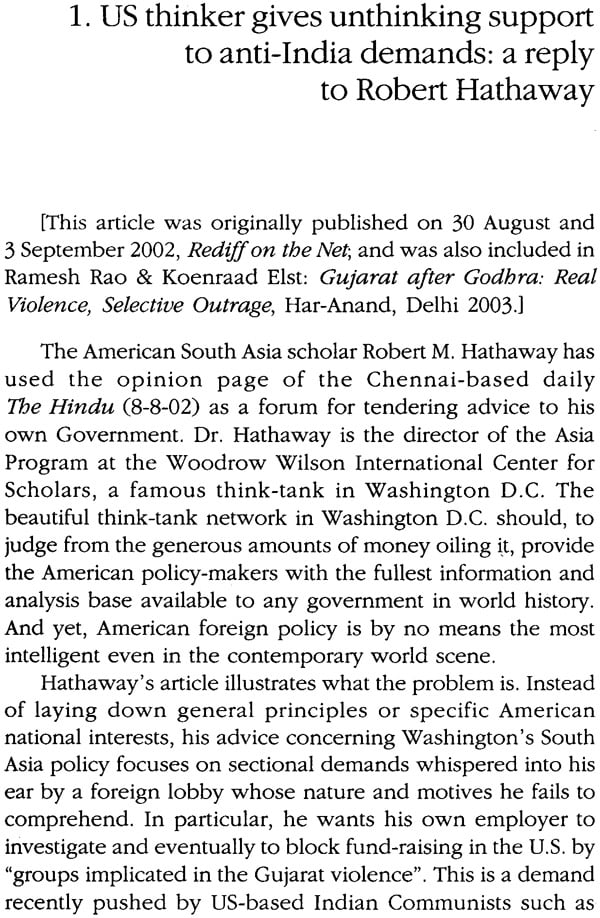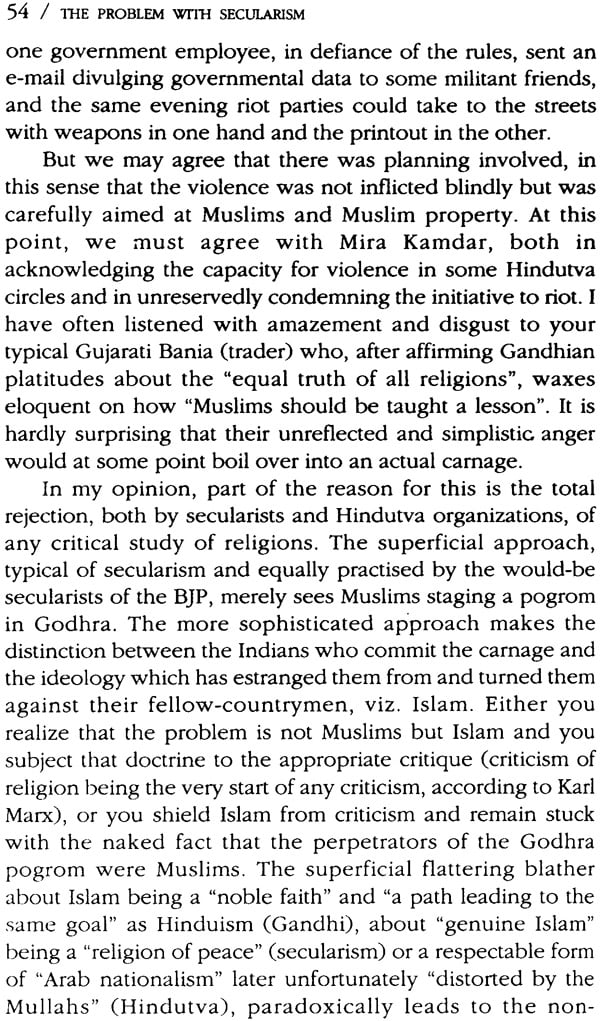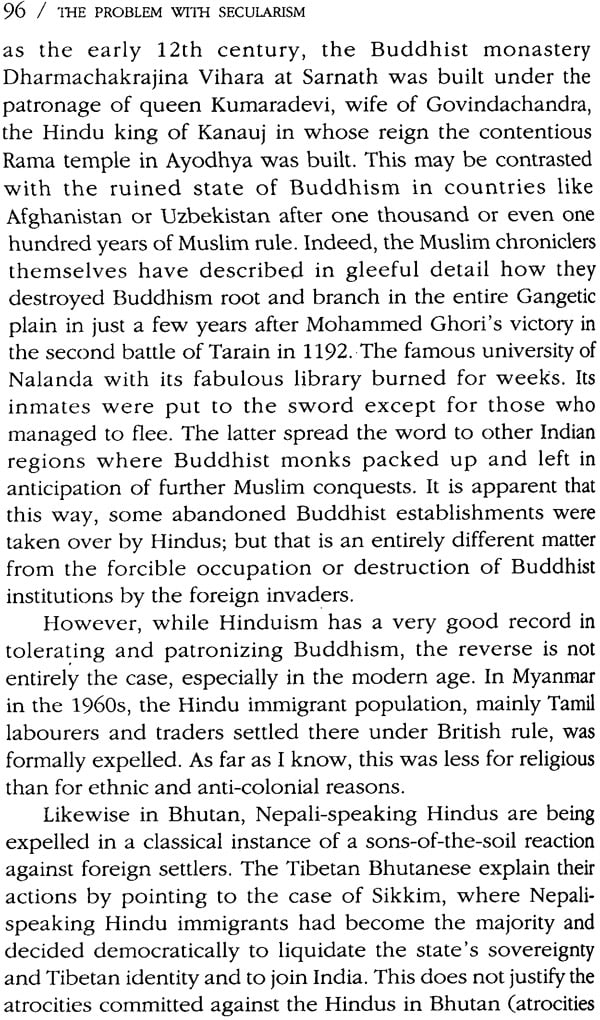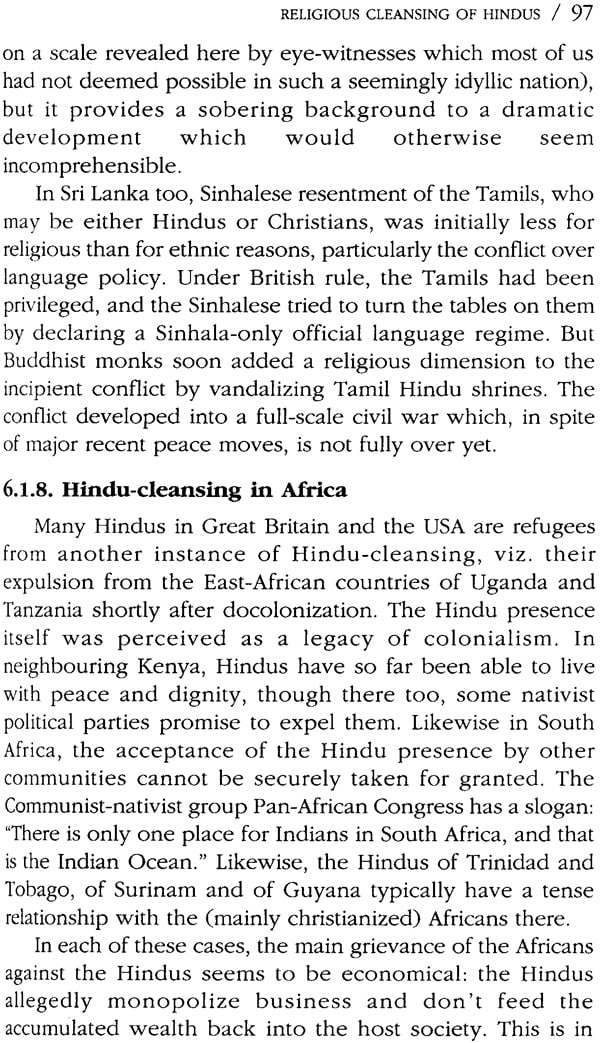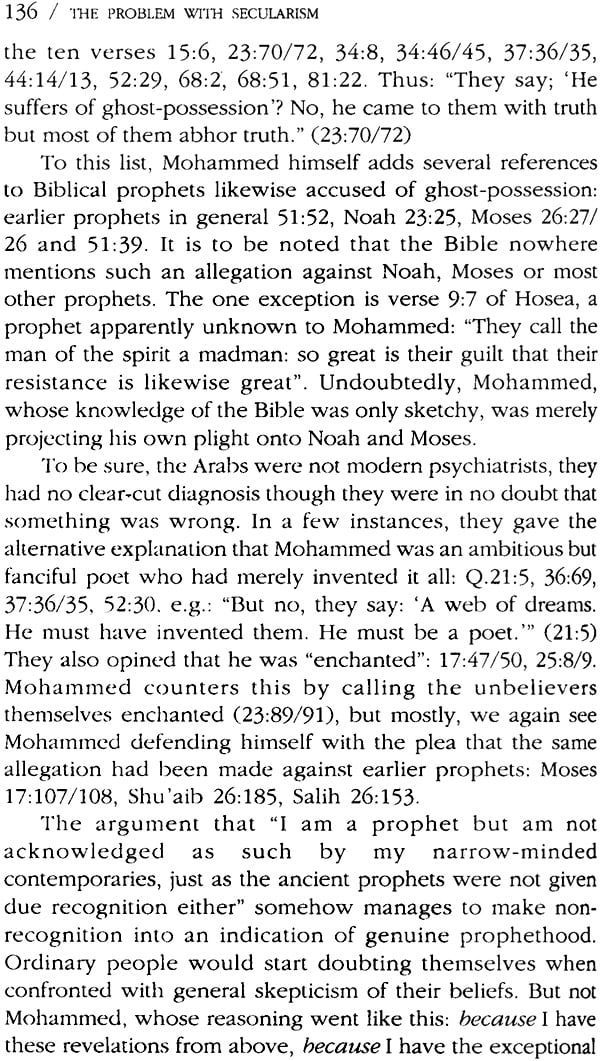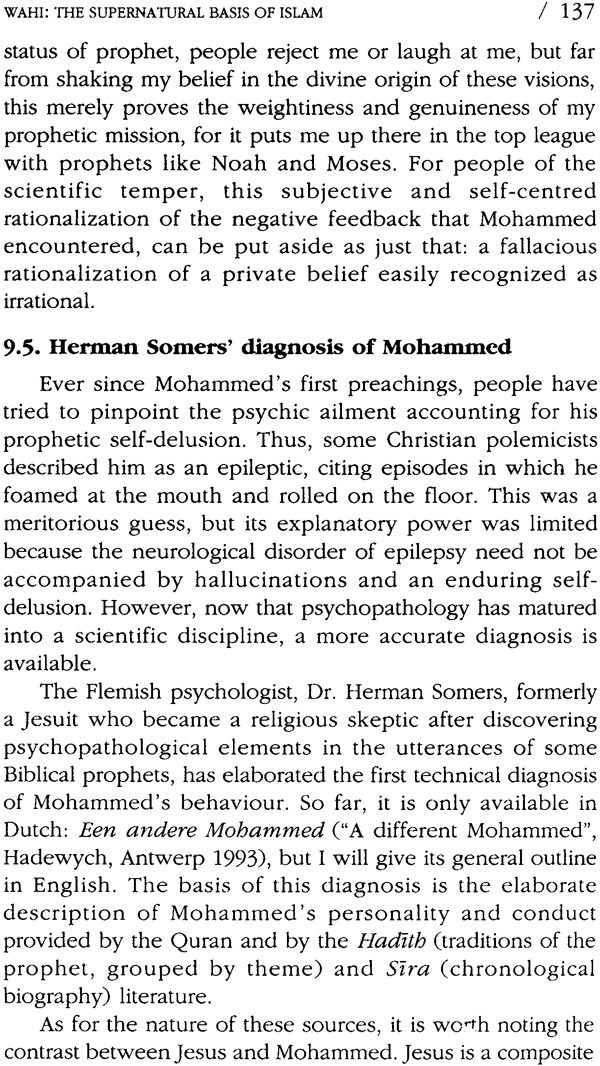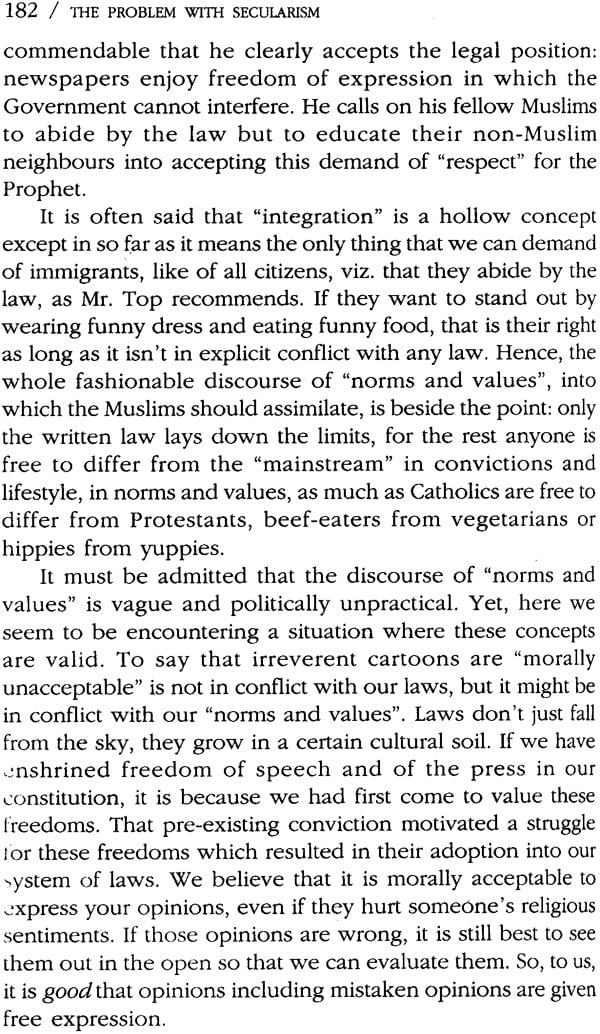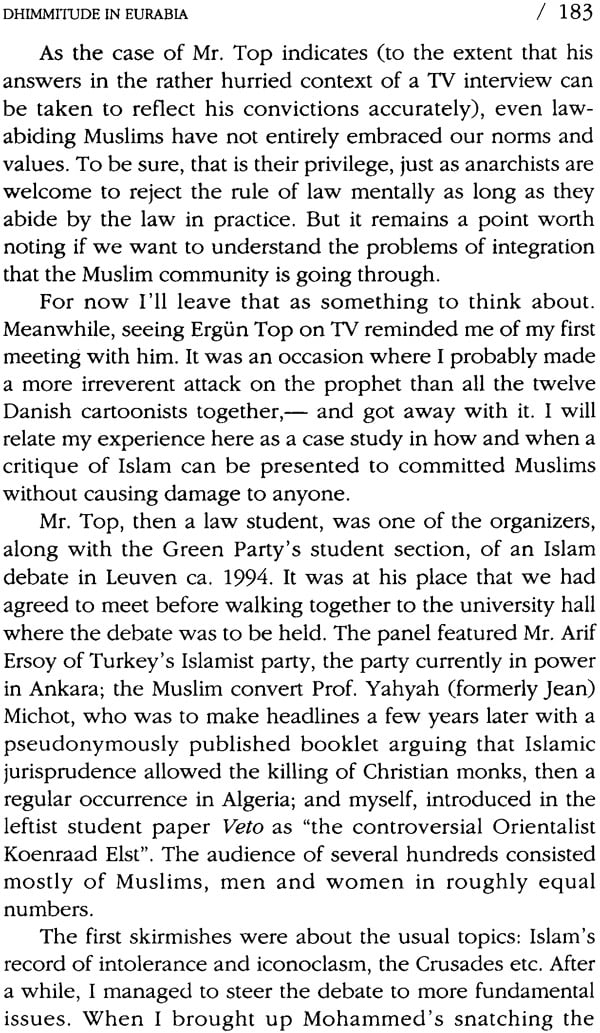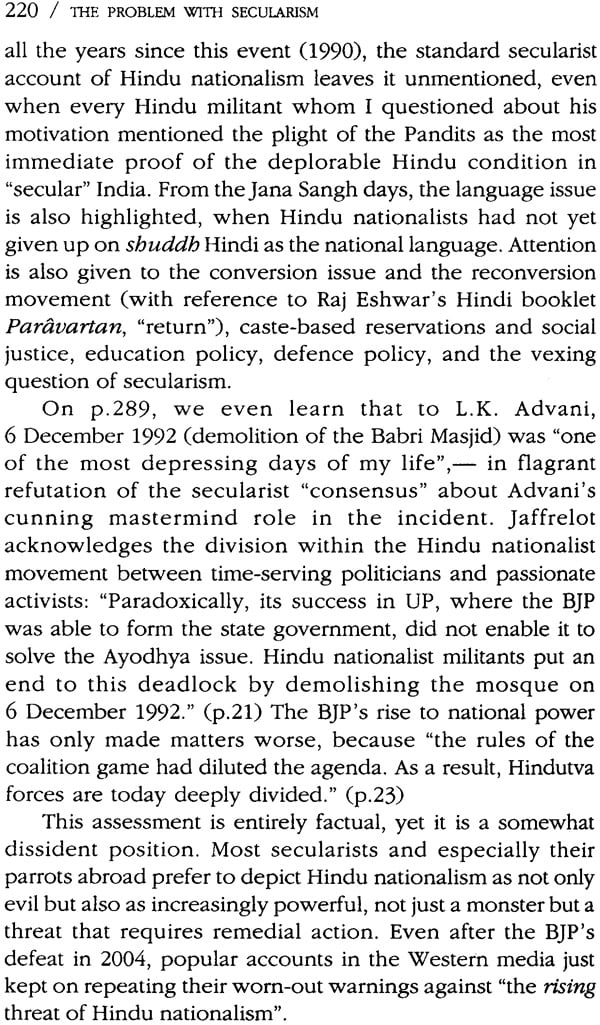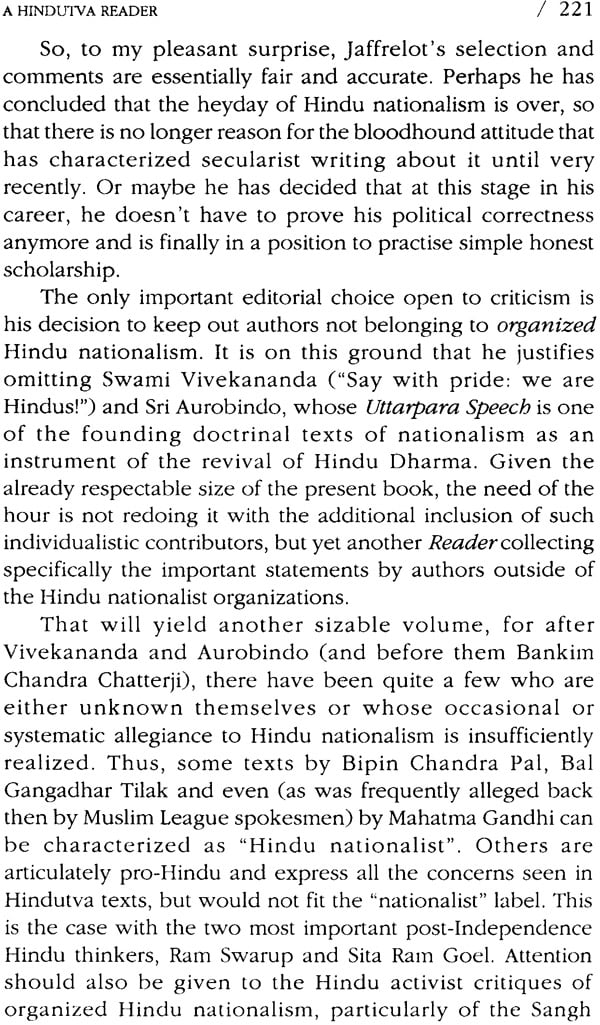
The Problem with Secularism
Book Specification
| Item Code: | NAM486 |
| Author: | Koenraad Elst |
| Publisher: | Voice of India, New Delhi |
| Language: | English |
| Edition: | 2015 |
| ISBN: | 9789385485022 |
| Pages: | 240 |
| Cover: | Paperback |
| Other Details | 8.5 inch X 5.5 inch |
| Weight | 320 gm |
Book Description
This book is a collection of articles about secularism and its relationship with religious communalism. In Christian Europe, secularism used to be a way of curtailing the intrusive power of the Churches. In India, however, "secularism" has acquired a wholly different meaning. Ever since the term was propagated by Jawaharlal Nehru, being an Indian secularist does not require you to reject theocracy and the intrusion of religion into politics. On the contrary, every obscurantist in India swears by "secularism". The word's effective meaning has shifted to a concern quite unknown to its European coiners, viz. the struggle against Hinduism. In political practice, as also in the editorial policies of the dominant media, secularists patronize all enemies of Hinduism: Islam, the Christian Churches, the communists and Naxalites, the anti-Hindu voice among Sikhs, Jains and neo-Buddhists, as well as mindless consumerism and every other trend that promotes Hindu cultural self-forgetfulness. The secularist-Islamist alliance is one of the wonders of the world and requires ever new exercises in hypocrisy on the part of the former, sometimes descending into grotesque buffoonery. It is a different matter that the hollow and crassly superficial ideology of Nehruvian secularism is secure in its power position because of the absence of credible Challengers. With a political opposition claiming to be "positive secularists" and "genuine secularists", India's official "pseudo-secularism" has no one to fear. In public discourse, Nehruvian secularism today is mainly a form of snobbery that confers a cheap moral superiority on self-hating Hindus to mark them off as enlightend sophisticates against the cramped and backward Hindu "fundamentalists". It relieves them, in the comfort of their positions of privilege, of the duty to look into the causes of Hindu discontent. It is hoped nonetheless that once in a while a sincere attempt to discuss matters can penetrate their wall of self-righteousness, and that this book will promote dialogue between the Nehruvian secularists and the rest of us.
Dr. Koenraad Elst (Leuven, Belguim, 1959) is a well-known Indologist and author of numerous books and papers on religio-political issues, incuding the Ayodhya controverss, the Sangh and non-Sangh tendencies in Hindu revivalism, the Islamic challenge to the multicultural Project, and the Aryan Invasion debate.
In the eight years since this book was first published a few things ought to have changed. In this new foreword I will explore these.
Feedback
Though I would like to report their answers to my critiques of their works, I have seen no reply by any of the people addressed here, such as Robert Hathaway, Richard Eaton, Mira Kamdar or Thomas Hansen. This is typical of secularist behaviour: while the record shows that I consider it normal to answer my critics, the other side occasionally lambasts me but does's bother refuting me. Either they are just too smug, comfortably established in their own academic positions, or they have decided not draw attention to the weakness of their positions.
No paper in this book, nor really any other book, has had any noticeable effect on organized Hindu activism. They give me the same silent treatment as the enemy side. Individual Hindus, by contrast, have informed me of their appreciation.
Failed predictions
Two trends mentioned in this book have not persisted. In Europe, the cleansing of Hindus has remained extremely marginal, limited to a few cases in former Soviet territories, now fiercely Christian. In the Anglosphere, there have been cases of Hindus, especially Sikhs, being confused with Muslims and therefore scolded. But Hinduism as such has not been the target of friction than can be expected between any two communities, at least in the West. Likewise in South Africa, Black majority rule has not, as I had feared, led to a repeat of the expulsion of "Asians" as in Uganda and Tanzania. Hindus had made themselves more acceptable by siding with the anti-Apartheid struggle, and this seems to have prevailed over basic ethnic hatreds.
In Muslim countries, by contrst, harassment of Hindus has continued. No government in Delhi has taken any steps against this phenomenon. The related Yezidis of northern Iraq even suffered mass rape, enslavement and killing at the hands of the Islamic State. Here at least, Hindu activists have shown solidarity and provided the only serious platform worldwide to Yezidi representatives. In advocacy for the Hindu refugees from Pakistan too, their effort has made a difference.
A needed correction concerns the title of chapter 7: "What if Rajiv Gandhi hadn't unlocked the Babri Masjid in 1986?" The title was given me by the magazine, Outlook India, but on second thought, that doesn't preclude a measure of responsibility for it. So, as a matter of correction, let temple (still with mosque architecture) for general Hindu worship, though it took place while he was in power. The temple was thrown open by Court order. It was not a political move in itself, but only a step in the very long-winded judicial process. Rajiv Gandhi was ready to make proper use of it, even being tipped for the stone-laying ceremony of the projected Hindu building. This was only one of several instances where the Congress Party favoured the Hindu demands concerning Ayodhya. Only after 1989 did it become identified with the BJP, opposed by all others.
Wahi, the prophetic trance
The part about Mohammed's mental affliction, "Wahi", follows a growing trend of medical diagnosis across the centuries. A good recent example is Delhi biotechnologist Ramakrishnan Sitaraman's paper: "Medical evidence as a decisive determinant of historicity in ancient texts: trimethylaminuria in the Mahabharata", (History Today, vo1.13, 2012, pp.1-6), about Matsyagandha ("having a fish-smell") Satyavati's disease described in the Mahabharata. The text faithfully describes, without understanding it, a case of the condition known as trimethylaminuria, or fish malodor syndrome, caused by a liver enzyme deficiency, in which a woman has a fish smell but can lose it due to hormonal changes, esp. in pregnancy.
Religion in the sense of "belief', while no doubt tougher than Lenin or Ataturk thought, is being battered by scientific findings. In India, the media are controlled by secularists who shield their readers and viewers from international developments not to their liking. That is why people tend to be insufficiently aware that an increasing number of publications confirm something amiss in Mohammed's psyche. Ibn Warraq, Ali Sina , Radheshyam Brahmachari, all represent this swelling recognition that Islam was spawned by a man's mental condition, a mere delusion. Islam is fundamentally a folie a deux (the phenomenon that someone close to a delusional person also starts to interiorize this delusion) on a billionfold scale. All those Muslims who only utter the name of Mohammed by wishing him peace, all claim to share his own belief that he was extraordinary. While Islam insists that Mohammed had no divine status, it treats him as an absolute precedent. In that sense, the obsolete European name Mohammedanism was correct.
In my book Psychology of Prophetism, I had already reported on the case against Jesus as made by a number of 20th-century psychiatrists. Sigmund Freud, who only knew about Judaism and Christianity, which strongly believe in a sovereign Creator-God and in "revelation", wrote about Religion, the Future of an Illusion. A very recent publication, by the American psychiatrists Evan D. Murray, Miles D. Cunningham and Bruce H. Price, viz. "The Role of Psychotic Disorders in Religious History Considered" (The Journal of Neuropsychiatry and Clinical Neurosciences, 24:4, Fall 2012, pp. 410-426), confirms the impression that the Jesus described in the Gospels suffered of a psychotic disorder. A lone Hindu sequel to this line of research is contained in What Every Hindu Should Know about Christianity by a Californian Hindu, Kalavai Venkat (2014).
After publishing my paper on Wahi, I did not receive any death threat snor even ordinary hate mail. This would not have been the case if I had lampooned the Prophet (cartoons) or attacked him in a cruder manner, particularly involving sex, as in Salman Rushdie's The Satanic Verses, of which most Muslims only knew that it "depicts the Prophet's wives as prostitutes". It seems Islamic radicals who not only threaten but actually commit violence, don't read abstruse academic papers. However, the Tamil translation, circulated as a booklet in its own right, did trigger death threats to the translator. Fortunately he had used a pseudonym. The secular establishment won't protect candid writers against fanatics, so they have to resort to their own devices.
Hindu precedent for Islamic iconoclasm?
Prof. Richard Eatons theory that Islamic iconoclasm, which he tries to minimize but nonetheless admits, is simply due to Hindu precedent, has gained ground among secularists. I have refuted it here as well as in my earlier book Ayodbya, the Case against the Temple, but to no avail. However, regardless of my own contribution to the debate, the secularists have at least decided that it is wiser not to deny Islamic iconoclasm completely anymore, as they did during the Ayodhya debate. So they have retreated to a next line of defence (of the Islamic record): admitting Islamic iconoclasm but blaming the Hindus for it.
I can only point to the argumentation I have developed in the past, and which remains completely unrefuted. There is simply no instance of a Muslim iconoclast citing Hindu precedent as his justification. On the contrary, wherever they feel a need to justify themselves, they refer to Islamic precedent, particularly to the Prophet's very own destruction of the 360 statues in the Kaaba of Mecca. Unlike the secularists, who pretend that the world ends at India's borders, Muslim war leaders were not so narrow-minded as to draw their inspiration exclusively from the history of India, with which they did not identify with anyway. Their behaviour pattern was quite like that of their Islamic colleagues in other parts of the world, and quite unlike that of Hindu kings.
Secularist book-banning
At several places in this book, I have discussed matters of book-banning and freedom of expression. About Christianity such demythologizing theories as mentioned in the Wahi section can now be openly talked and written about. It is only in India that this discourse is muzzled by the still-preponderant secularist hold on the public debate. (Western readers will be surprised that a pressure-group in favour of opinion control regarding religion can be called "secularist", but in India this term is used for anything anti- Hindu ergo including pro-Christian.)
Article 295A of the Indian Penal Code punishes writers in case they, through their publications, have offended the tender feelings of a religious community. The influence of this law extends much farther than its literal application. Authors, publishers and editors practise self-censorship in order to be on the safe side of this penal provision. The law was enacted to protect Islam from critical scrutiny by a Hindu (Arya Samaj) author, but the Churches have also taken umbrage behind it, such as to proscribe Dan Brown's fictional thriller The Da Vinci Code.
However, it is only when Hindus started using it to get UR Ananthamurthy's book 300 Ramayanas and Wendy Doniger's Alternative History of the Hindus banned, that Western Indologists started demanding that this Article be scrapped, mercifully not realizing its pro-Islamic origins. Me too, I signed two petitions against this banning, one of them circulated by Laurie Patton and led by Romila Thapar. Admittedly these books are flawed in their assumptions, factually riddled with errors, and simply anti-Hindu. But that counts for numerous books and can be no valid excuse for banning them: the only right answer to a flawed book is another book. In the case of Wendy Doniger, a counter- book detailing its errors was indeed provided by Vishal Agarwal (digitally 2009, in print 2014).
Secularism and the BJP government
In the realm of facts, the biggest event since the first print-run of this book has been the election of a BJP government in May 2014. Given the abysmally bad performance of the preceding Congress government, it had been expected that the BJP would win; more than likely, it was going to be a relative majority necessitating a coalition. The coalition partners were then expected to veto the choice of Narendra Modi, so that Rajnath Singh would become Prime Minister. That was the scenario preferred by the time-servers and opportunists in the BJP. However, the campaigning by Modi and his team of whiz kids generated such enthusiasm at the mass level that the otherwise apathetic Hindu voters turned out in record numbers and gave the BJP a solid majority. Countless people, from Baba Ramdev on down, testified that they had voted for Modi, not for the BJP.
At any rate, after giving the throne to Modi, it was the BJP that profited. All manner of people who had never done anything for the Hindu cause came to man the ministerships, chairs of committees and other plum posts that the BJP was now in a position to dole out. Many well-known faces of the secularist camp suddenly discovered the BJP activist in themselves and acceded to the Modi camp. In there, they have gone on promoting secularism and treating Hindu concerns as backward and outdated. The bygone antagonism between the "Hindu fanatical" BJP and so-called "pseudo-seculars" has been replaced by an antagonism between the secularist and Hindu wings within the BJP. Hindu society as such remains under represented.
| Foreword to the 2015 edition | xi | |
| Foreword | xix | |
| Chapter 1. | Us thinker gives unthinking support to anti-India demands: a reply to Robert Hathaway | 1 |
| Chapter 2. | "Indian secularism is systematically dishonest" | 11 |
| Chapter 3. | The Saffron Wave | 34 |
| Chapter 4. | The struggle for India's soul: A reply to Mira Kamdar | 41 |
| Chapter 5. | Learning from Mahatma Gandhi's mistakes | 78 |
| Chapter 6. | Religious cleansing of Hindua | 88 |
| Chapter 7. | What if Rajiv Gandhi hadnit't unlocked the Babri Masjid in 1986? | 111 |
| Chapter 8. | No Hindu justification for Islamic iconoclasm | 115 |
| Chapter 9. | Wahi: the supernatural basis of Islam | 120 |
| Chapter 10. | Let's combat communalism | 152 |
| Chapter 11. | Dhimmitude in Eurabia | 178 |
| Chapter 12. | The case of M.F. Husain | 206 |
| Chapter 13. | A Hindutva reader | 216 |
